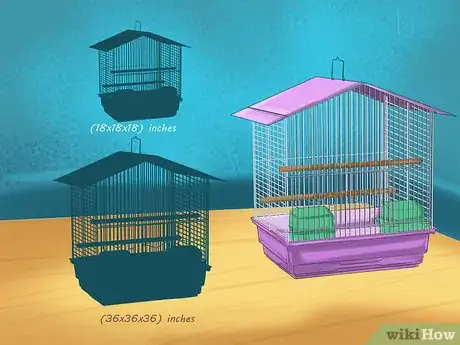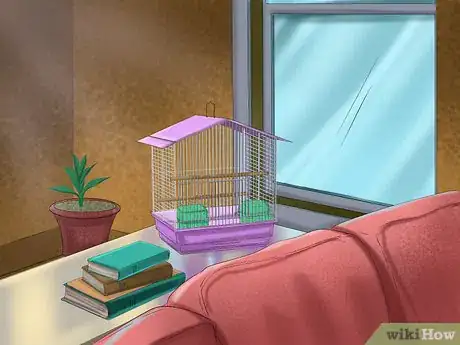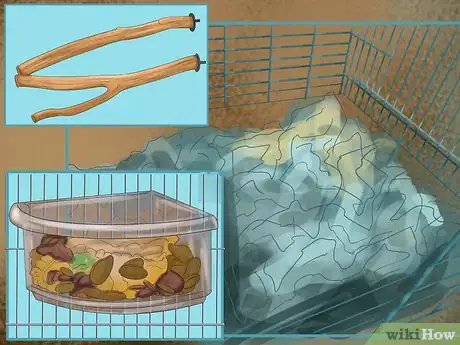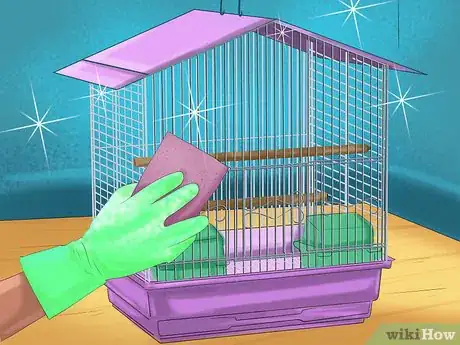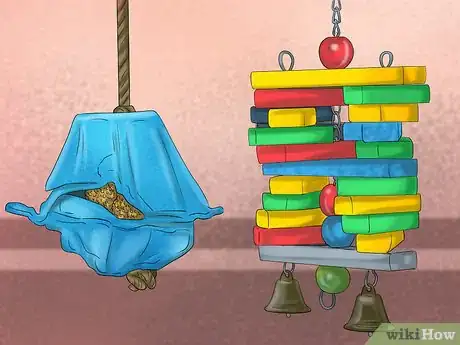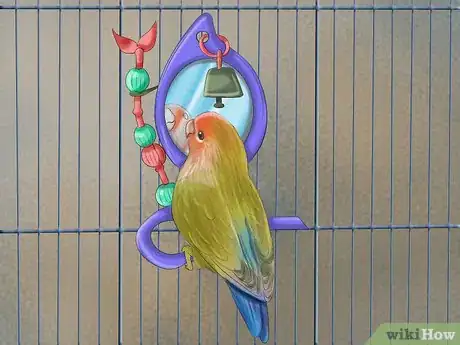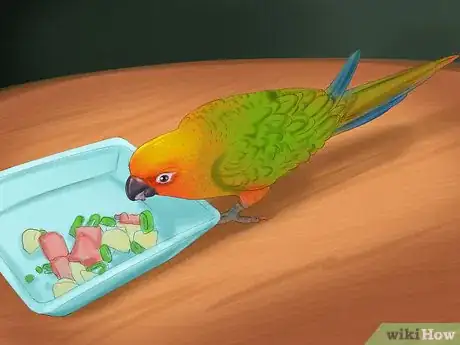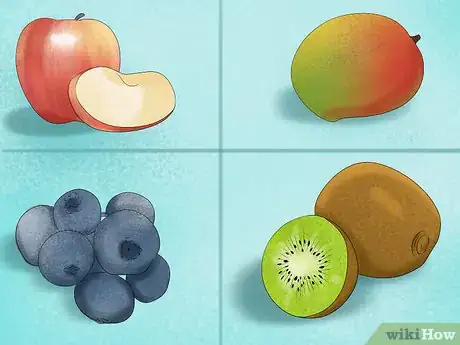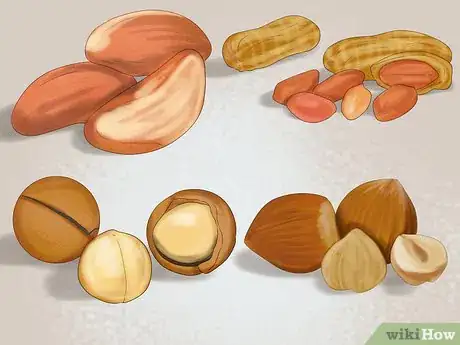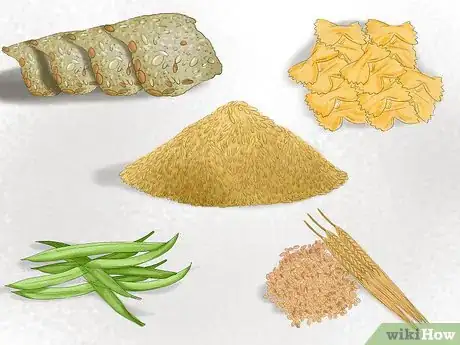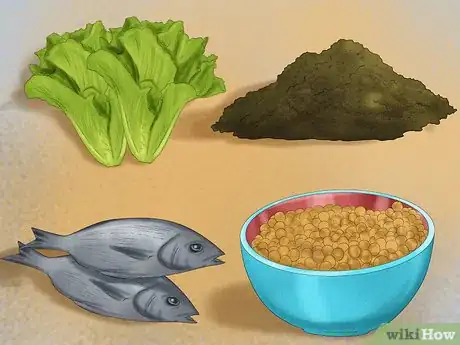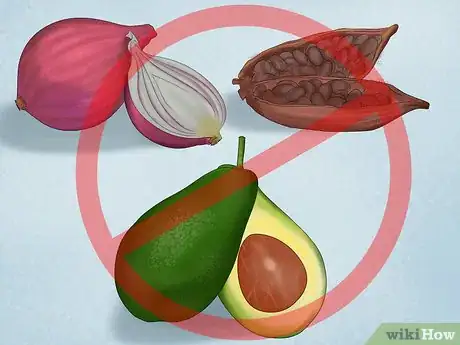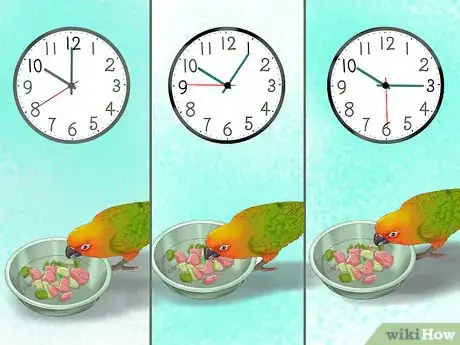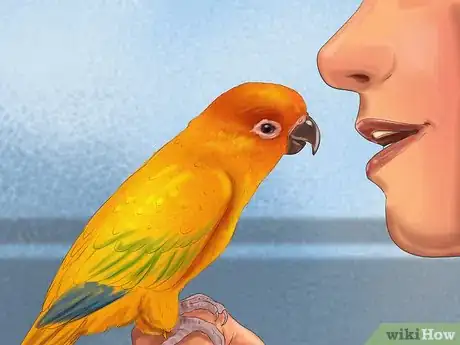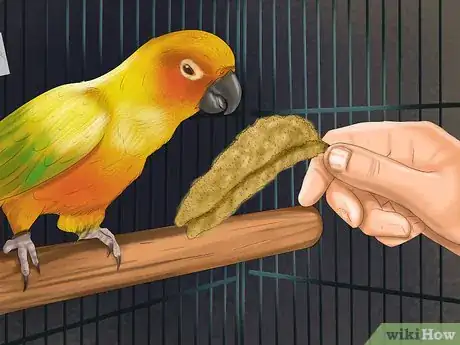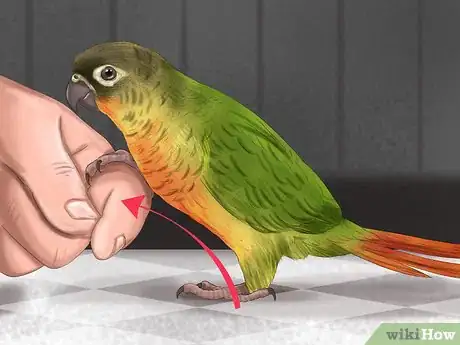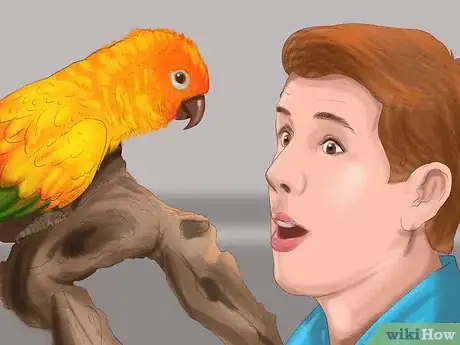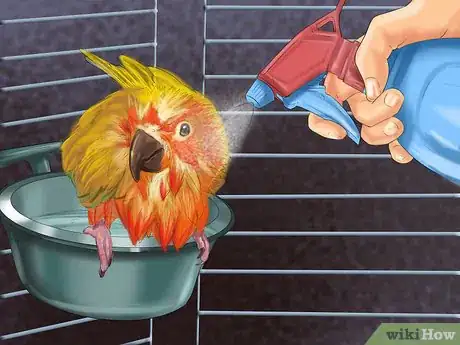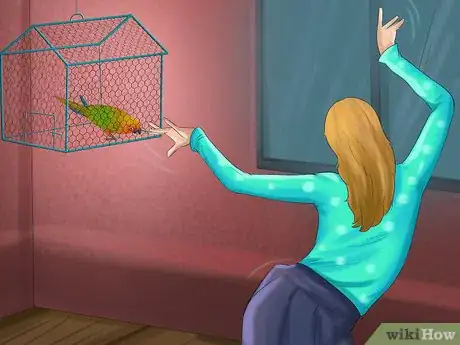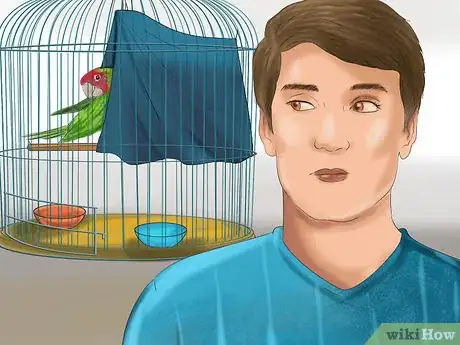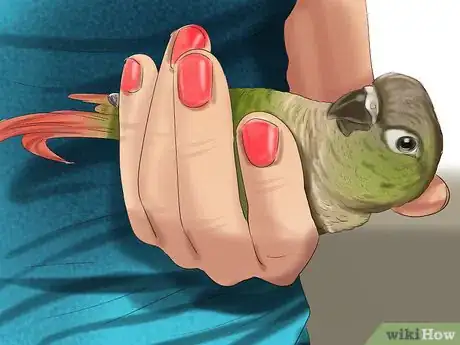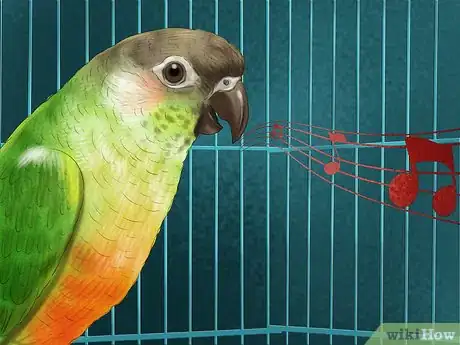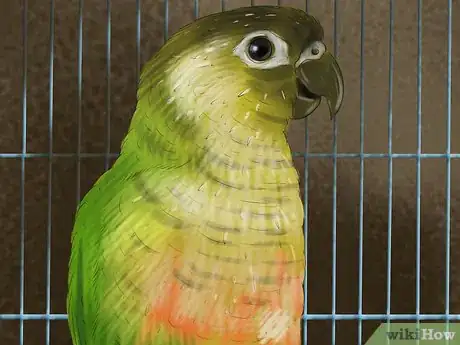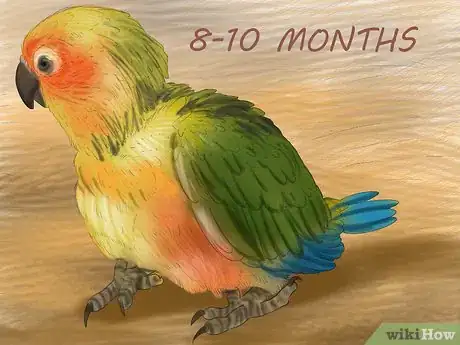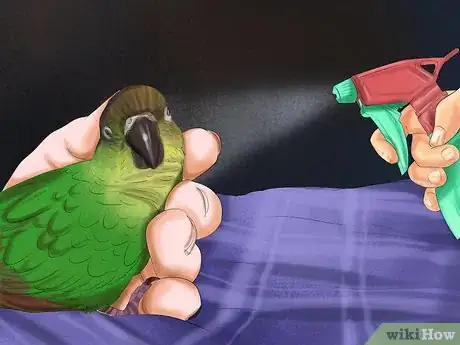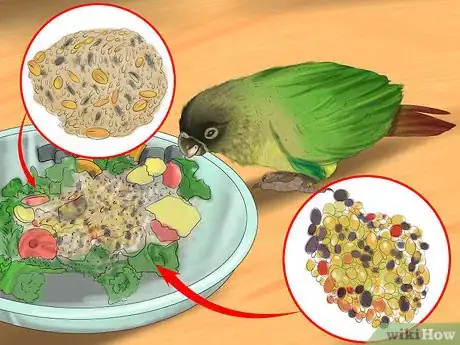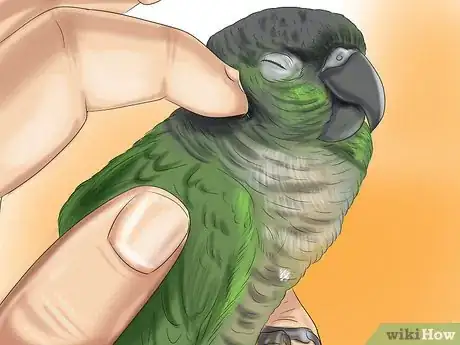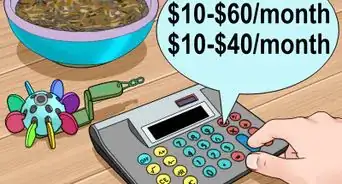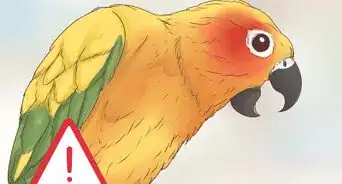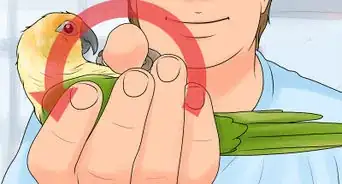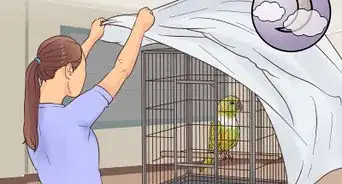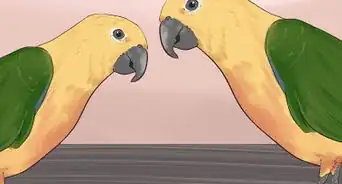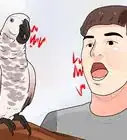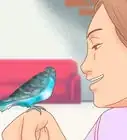This article was co-authored by Pippa Elliott, MRCVS. Dr. Elliott, BVMS, MRCVS is a veterinarian with over 30 years of experience in veterinary surgery and companion animal practice. She graduated from the University of Glasgow in 1987 with a degree in veterinary medicine and surgery. She has worked at the same animal clinic in her hometown for over 20 years.
There are 18 references cited in this article, which can be found at the bottom of the page.
wikiHow marks an article as reader-approved once it receives enough positive feedback. This article received 36 testimonials and 96% of readers who voted found it helpful, earning it our reader-approved status.
This article has been viewed 521,428 times.
Conures, a type of parrot, are very popular pet birds. Besides being pretty to look at, conures have personality traits (spunky, comical, cuddly, playful) that make them easy to love.[1] With proper care, your conure can live for 20 to 30 years,[2] giving you plenty of time to develop and cultivate a loving companionship with him.
Steps
Housing Your Conure
-
1Select a cage. Conures are active birds that like to keep busy.[3] Your conure will need a cage that gives him lots of space to move around and play with his toys.[4] If you have a small conure, his cage should be at least 18 x 18 x 18 inches (46 x 46 x 46 centimeters).[5] A larger conure would need a cage that is at least 36 x 36 x 36 inches (91 x 91 x 91 centimeters). [6]
- The cage can be either horizontal or vertical.[7]
- The cage bars should be horizontal so your conure can climb on them.[8] The bars should be spaced no further than 3/4 inches to one inch (two to 2.5 cm) apart.
- Consider purchasing a cage cover to give your conure a sense of security when he sleeps.[9] Alternatively, you could use a blanket or large towel to cover his cage at night.
-
2Situate the cage in an ideal location in your home. Your conure's cage should be in a room that is not in the direct path of harmful kitchen fumes.[10] Within the room, make sure not to place the cage in direct sunlight.[11] Conures are most comfortable in rooms that are 70 to 80 °F (21 to 27 °C), which is the typical room temperature for most homes.
- The room should also be free of drafts.[12]
- Many types of fumes are toxic to conures, including perfumes, aerosols, and fumes from cleaning products and non-stick cookware.
Advertisement -
3Place some basic items in your conure's cage. Perches are an essential item in any bird's cage. For your conure, choose at least two perches that are 1/2 to 5/8 inches (about 1.5 centimeters) in diameter.
- Position the perches such that your conure's tail feathers will not rub against the cage bars when she sits on the perches.[13] Place one perch close to your conure's food and water dishes.[14]
- Consider using perches that have various sizes, shapes, and textures. This will help keep your conure's feet healthy and strong.[15] Many types of perches are available at your local pet store.
- Place two to three food and water dishes in her cage. One dish would be for water and one or two would be for food.
- Conures love to take baths. Place another water dish in your conure's cage,[16] preferably one that is large enough for her to step in. Look for these dishes at your local pet store or housewares store.
- Line the bottom of your conure's cage with newspaper or paper liners.[17]
-
4Clean your conure's cage regularly. Conures can be messy, so you will need to maintain a regular cleaning schedule for your conure's cage. On a daily basis, you should clean his water and food dishes.[18] Conures like to dip their food in their water bowls, so you may need to clean your conure's water dish several times a day.[19]
- Replace the cage lining each day.[20]
- Clean your conure's toys and perches on a daily basis. Dishwater detergent is sufficient for cleaning these accessories. Make sure to completely rinse off the soap before placing the cleaned items back in your conure's cage.[21]
- Depending on how messy your conure is, you will need to disinfect his cage either weekly or monthly.[22] Since bleach fumes can be toxic to your conure, you will need to keep him in a separate room when you disinfect his cage and allow it to dry.[23]
- Speak with an avian veterinarian or avian expert about safe cleaning products to use in your conure's cage.
Enriching Your Conure's Cage
-
1Place toys in your conure's cage. Conures like to be kept busy. Without things to do, your conure could become bored and resort to feather picking.[24] Giving your conure a variety of toys will keep her happily entertained. Popular toy types for conures include foraging toys, wooden chew toys, and shredding toys.
- Foraging toys mimic your conure's natural food foraging behavior in the wild.
- Shredded toys can help your conure relieve stress and boredom. If you don't want to purchase a shredded toy, you can place some newspaper in the cage for him or her to shred.
- Avoid toys that have small parts. These parts could catch on your conure's beak or claws, possibly leading to damage or injury.[25]
- Keep different types of toys at your conure's cage at all times to prevent boredom with any one toy.
- Consider installing a play stand in your conure's cage that can hold toys.[26]
- All types of toys can be found at your local pet store.
-
2Provide an exercise outlet for your conure. Conures need lots of exercise to stay happy and healthy. Swings, and ladders would provide your conure with plenty of exercise during the day.< For the ladders and swings, install them at heights inside the cage that will keep your conure's tail from rubbing up against the cage bars.
-
3Consider putting a mirror in your conure's cage. Mirrors can be a good choice of enrichment to keep your conure busy. However, introduce him to a mirror only after he has bonded with you—otherwise he may bond with the mirror instead of you![27]
- Mirrors can also encourage mating behavior (e.g., regurgitating food, tail lifting).[28]
- Mating behavior can be especially problematic in female birds, since they can lay eggs without a mate. If you have a female conure, mating behavior can lead to spontaneous egg laying that could result in physical stress and illness.[29]
- Your conure could see the mirror as a "love toy."[30]
- Speak with your veterinarian if you are unsure about placing shiny objects in your conure's cage.
Feeding Your Conure
-
1Select a pelleted food and seed mix for your conure. Pelleted bird food is commercially available at your local pet store. Pellets should make up approximately 60 to 70% of your conure's diet and seeds no more than 10% and fruits and veggies for the rest. They can come in different colors, which adds a little variety to an otherwise uninteresting food.[31]
- Pelleted bird food, along with seed mixes, provide a good, nutritious diet.
- Some commercial seed mixes have fillers or harmful additives. Ask an avian veterinarian or the staff at your local pet store if you are unsure about which pelleted food and seed mix would be best for your conure, or select a seed mix that is labeled as "organic" or "all natural."
-
2Add fresh fruits and vegetables to your conure's diet. Variety is key to feeding your conure a nutritionally balanced diet. Fruits and vegetables are a great way to add this variety. Examples of fresh vegetables to feed your conure are collard greens, spinach, pumpkins, and zucchini.[32]
- There are many types of fruit you can feed your conure, such as mangoes, blueberries, kiwi, and apples.
- Fruits and vegetables also add important vitamins and minerals to your conure's diet.[33]
- Wash the fruits and vegetables thoroughly with water to remove pesticides.[34]
- Consider purchasing organic produce but not avocado because it is poisonous to your bird.[35]
- Cut the produce into smaller pieces.
-
3Incorporate nuts into your conure's diet. Nuts add healthy protein and fat to your conure's diet, and should be a mainstay in her daily eating regimen.[36] Examples of nuts to feed your conure are hazelnuts, macadamia nuts, peanuts, and brazil nuts.[37]
- The nuts should be low in salt.
- Although important, nuts should be fed only in small amounts because of their high fat content. Your conure could become obese if she eats a lot of nuts.[38]
- If you feed your conure peanuts, they must be unshelled. [39] Peanut shells contain a fungal toxin called aflatoxin that could make your conure very sick.
-
4Give your conure grains and legumes to eat. In addition to nuts, grains and legumes are mainstays of a conure diet. There are many types of healthy grains you can feed your conure, such as cooked brown rice or barley, as well as cereal, pasta, and crackers.[40]
-
5Supplement your conure's diet with extra vitamins and minerals. You may need to supplement your conure's diet with certain nutrients, including calcium and vitamin K. Incorporate foods into his diet (dark leafy greens, soy oil, and fish meal) that are high in these nutrients. Adequate amounts of calcium and vitamin K are important to prevent a condition called Conure Bleeding Syndrome.
- Calcium perches are available that your conure can chew on to get extra calcium in his diet. Cuttlebone is another calcium source, but is not recommended for conures.
- Water-soluble vitamins can be added to your conure's water.
- Speak with your veterinarian before supplementing your conure's diet.
-
6Avoid feeding your conure certain foods. Conures are not picky eaters.[43] However, there are certain foods that she should not eat. For example, your conure should not eat avocados, cocoa, or onions. These foods contain toxins that could sicken your conure.
- Human foods that are high in sugar, salt, or fat should also be avoided, since a conure's digestive system cannot break them down very well.[44] Processed foods tend to be high in these ingredients.
-
7Develop a feeding regimen for your conure. Feed your conure once in the morning and once in the evening. At each feeding time, place a variety of fresh foods, cooked foods, and seeds in his food dishes. After about one hour, remove any remaining food.[45]
- In the morning, give him some pellets after you have removed the other food. He can snack on the pellets throughout the day.[46]
- Conures are prone to obesity. To prevent him from overeating at mealtime, feed him only as much as he can eat in one sitting.[47] It will probably take some trial and error to determine how much to feed him at mealtime.
- Since conures are messy eaters and like to dip their food in their water, you may have to replace your conure's water dish at each meal time.
Interacting With Your Conure
-
1Gain your conure's trust. Since conures are very social and outgoing birds, interacting with your conure is important to his overall care. To have quality interactions with her, you will first need to gain her trust. One way to gain her trust is to talk to her in a smooth and calming voice.[48]
- Talk to her throughout the day, especially when you are feeding her and cleaning her cage.
- The more she hears your voice when you are near her, the more comfortable she will be with you.
- Another way to gain her trust is to approach her cage slowly and calmly. When she sees that you are not a threat, she will be much more at ease when you are nearby.
-
2Acclimate your conure to your hand. In addition to trusting you, your conure will also need to be comfortable with your hand. Begin by gently placing your hand either on or near the outside of his cage.[49] Talk to him while you hold your hand nearby to calm his anxiety.
- When your conure is comfortable with your hand outside his cage, slowly place your hand inside his cage.[50] Hold some treats (e.g., millet spray, dark leafy greens) in your hand and keep your hand still while he approaches and explores your hand.
- It may a few days or a few weeks before your conure is comfortable with your hand. Just be patient with him.
-
3Teach your conure to step up. When your conure trusts you and is comfortable with you, you can have all types of fun with her. For example, you can teach her to step up. Using your index finger as a perch, gently press your finger against her lower chest (just above her feet) to encourage her to step up onto your finger.[51]
- Give her a treat and verbal praise when she steps onto your finger.
- When she gets good at stepping onto your finger, you can take her out of his cage and practice stepping up in a different room, such as the bathroom.
-
4Teach your conure to talk. Parrots are known for their ability to talk. However, conures are not as good as other parrot species when it comes to talking ability.[52] Try as he might, your conure will probably be able to learn only about five or ten words.
- Your conure will need to focus all of his attention on you to learn how to talk. Turn off any other noises (television, radio, phone) that may distract him.[53]
- Choose simple words and phrases, and associate them with a specific object or action.[54] For example, you can say "Are you hungry?" when you feed him and "Goodbye!" when you leave the room.
- Speak with enthusiasm to your conure. The more excited you sound, the more excited and motivated he will be to mimic your words.[55]
- Your conure's voice will be high pitched.[56]
-
5Help your conure with her morning bath. Another way to interact with her is to help her take her morning bath. Use a spray bottle to gently spritz her with a mist of water.[57]
- If she will let you, gently wrap your conure in a towel after her bath and hold her close to you until she is dry.[58] Conures are very cuddly, so your conure will probably enjoy being so close to you after a good bath.
- When she is dry, your conure will preen herself. To preen, she will use her beak to reach back to her oil gland (located at the base of her tail) and spread the oil over her plumage.[59]
-
6Dance with your conure. Believe it or not, conures have rhythm and like to dance![60] When your conure is excited or is trying to copy your movements, he will sway back and forth. If you like to dance, turn on some music and dance in front of your conure. Watch in amusement as he sways from side to side to match your movement.
-
7Play with your conure. Playing with your conure is a great way to interact with her. A simple game is "peek a boo." Simply wrap her in a towel and say "peek a boo" when you uncover her face.[61] Do this any many times as you want—chances are your conure will love to play this with you over and over.
- Play fetch with your conure. Toss a soft stuffed toy towards your conure.[62] Be aware that she might not be very good at catching what you toss, but she will have fun anyway. She may even toss the toy back to you.[63]
- Mimic your conure's actions and vice versa. For example, when your conure stretches her wings, stretch your arms out in response.[64] Move side to side, and see if your conure will do the same.
- Make a mess with your conure. Conures love to shred things. When you have your conure out of her cage, sit on the floor with her and make a mess by shredding some newspaper. Give her her own newspaper to shred.[65]
-
8Teach your conure to lay on his back. Conure owners like to teach this popular trick to their birds. With your conure perched on your finger outside of his cage, place him against your chest with his back facing away from you. Gently place your free hand on his back and begin to bend your body forward very slowly.
- Keep your hand on your conure's back as you bend forward. Lying back may feel a bit strange to your conure at first, so he will need your hand on his back to feel more secure with this movement.
- When he is comfortable lying back on your hand, you can play with him by tickling his tummy.[66] You could also give him small toys that he can play with when lying on his back.[67]
- When your conure can lie back, you can teach him more advanced tricks like doing back rolls.[68]
-
9Ignore your conure's screeches. As important as it is to interact with your conure, you should not pay her attention when she screeches. Conures are prone to making very loud noises.[69] As ear piercing as these screeches can be, do your best to ignore her when makes this noise.
- If you go over to her cage when she screeches, she may learn that she can screech to get your attention. To her, your attention is a reward for her behavior.
- Interacting with your conure on a regular basis and giving him plenty of toys to play with may help to temper his screeches.
Preparing Your Conure for Molting
-
1Understand that most birds need to molt. Molting happens to a bird when its feathers naturally shed and new ones replace the old ones. Molting is necessary to any bird's (including conures') growth.
-
2Know the age of your conure. Molting begins when the conure is around 8 to 10 months of age and continues on every year. The season in which molting occurs depends on the species of the conure.
-
3Understand the conure's stress. The conure will be more annoyed and won't be too cooperative. The conure will feel itch due to the new feathers growing out. Water could be sprayed on the conure to relieve the itchiness.
-
4Feed your conure food rich in protein as this will help the new feathers grow back on.
-
5Preen your conure. This could be done by gently brushing your hand on the conure's body to help the new feathers to come out. If you have a couple of conures who are molting at the same time, the conures can support each other by preening each other and rubbing their bodies against each other.
- Preen gently as new feathers could be painful to the conure when touched.
Expert Q&A
Did you know you can get premium answers for this article?
Unlock premium answers by supporting wikiHow
-
QuestionIs it a good idea to train a conure?
 Pippa Elliott, MRCVSDr. Elliott, BVMS, MRCVS is a veterinarian with over 30 years of experience in veterinary surgery and companion animal practice. She graduated from the University of Glasgow in 1987 with a degree in veterinary medicine and surgery. She has worked at the same animal clinic in her hometown for over 20 years.
Pippa Elliott, MRCVSDr. Elliott, BVMS, MRCVS is a veterinarian with over 30 years of experience in veterinary surgery and companion animal practice. She graduated from the University of Glasgow in 1987 with a degree in veterinary medicine and surgery. She has worked at the same animal clinic in her hometown for over 20 years.
Veterinarian That is great. Training a bird is a wonderful idea as it provides mental stimulation for the bird and helps him to bond with you. Conures respond well to reward-based training, and it can be particularly fun to use a clicker (such as dog trainers use) to mark the desirable behaviors so he understands what action it was that earned a reward. This will then make him keen to repeat it, which is what training is all about.
That is great. Training a bird is a wonderful idea as it provides mental stimulation for the bird and helps him to bond with you. Conures respond well to reward-based training, and it can be particularly fun to use a clicker (such as dog trainers use) to mark the desirable behaviors so he understands what action it was that earned a reward. This will then make him keen to repeat it, which is what training is all about. -
QuestionWhat does the head bobbing mean?
 Pippa Elliott, MRCVSDr. Elliott, BVMS, MRCVS is a veterinarian with over 30 years of experience in veterinary surgery and companion animal practice. She graduated from the University of Glasgow in 1987 with a degree in veterinary medicine and surgery. She has worked at the same animal clinic in her hometown for over 20 years.
Pippa Elliott, MRCVSDr. Elliott, BVMS, MRCVS is a veterinarian with over 30 years of experience in veterinary surgery and companion animal practice. She graduated from the University of Glasgow in 1987 with a degree in veterinary medicine and surgery. She has worked at the same animal clinic in her hometown for over 20 years.
Veterinarian
Warnings
- Certain fumes (perfumes, aerosols, heated non-stick cookware) are toxic to conures.⧼thumbs_response⧽
- Peanut shells contain a fungal toxin called aflatoxin, which is toxic to conures. If you feed your conure peanuts, make sure to remove the shells first.⧼thumbs_response⧽
- Certain foods—cocoa, avocados, onions—are toxic to conures.⧼thumbs_response⧽
- Conures tend to bond to one person and can be nippy with people they do not know.[75]⧼thumbs_response⧽
- Conures tend to screech, which can be very bothersome.[76]⧼thumbs_response⧽
- Conures can resort to feather picking—a serious behavioral problem in which they pluck out their feathers. Feather picking is a form of self-mutilation which can can result from boredom and stress. Other than providing more environment enrichment for your bird, you should also talk with your veterinarian about ways to stop the feather picking.[77]⧼thumbs_response⧽
- Female conures can spontaneously lay eggs, which can lead to nutritional deficiencies, osteoporosis, and other serious illnesses.[78]⧼thumbs_response⧽
References
- ↑ https://lafeber.com/pet-birds/species/conure/
- ↑ https://lafeber.com/pet-birds/species/conure/
- ↑ https://lafeber.com/pet-birds/species/conure/
- ↑ https://lafeber.com/pet-birds/species/conure/
- ↑ http://www.peteducation.com/article.cfm?c=15+1840&aid=2404
- ↑ http://www.peteducation.com/article.cfm?c=15+1840&aid=2404
- ↑ http://www.petparrots101.com/conures.asp
- ↑ http://www.petparrots101.com/conures.asp
- ↑ http://www.petparrots101.com/conures.asp
- ↑ http://www.birdchannel.com/bird-housing/bird-housing-accessories/new-bird-home.aspx
- ↑ http://www.petparrots101.com/conures.asp
- ↑ http://www.thatpetplace.com/sun-conures-article
- ↑ http://www.petparrots101.com/conures.asp
- ↑ http://www.drsfostersmith.com/pic/article.cfm?aid=288
- ↑ http://www.thatpetplace.com/sun-conures-article
- ↑ https://lafeber.com/pet-birds/species/conure/
- ↑ http://www.peteducation.com/article.cfm?c=15+1794&aid=2837
- ↑ http://www.petparrots101.com/conures.asp
- ↑ http://www.petparrots101.com/conures.asp
- ↑ http://www.peteducation.com/article.cfm?c=15+1794&aid=2837
- ↑ http://www.thatpetplace.com/sun-conures-article
- ↑ http://www.peteducation.com/article.cfm?c=15+1794&aid=2837
- ↑ http://www.thatpetplace.com/sun-conures-article
- ↑ http://www.petmd.com/bird/conditions/skin/c_bd_feather_plucking
- ↑ http://www.petparrots101.com/conures.asp
- ↑ http://www.petparrots101.com/conures.asp
- ↑ http://www.thatpetplace.com/sun-conures-article
- ↑ http://www.forthebirdsdvm.com/pages/discouraging-breeding-behavior-in-pet-birds
- ↑ http://www.forthebirdsdvm.com/pages/discouraging-breeding-behavior-in-pet-birds
- ↑ http://www.forthebirdsdvm.com/pages/discouraging-breeding-behavior-in-pet-birds
- ↑ http://www.petparrots101.com/conures.asp
- ↑ http://www.petuniversity.com/birds/parrots-and-parakeets/feeding-parrots.htm
- ↑ http://www.petuniversity.com/birds/parrots-and-parakeets/feeding-parrots.htm
- ↑ http://www.petuniversity.com/birds/parrots-and-parakeets/feeding-parrots.htm
- ↑ http://www.petuniversity.com/birds/parrots-and-parakeets/feeding-parrots.htm
- ↑ http://www.petuniversity.com/birds/parrots-and-parakeets/feeding-parrots.htm
- ↑ http://www.petuniversity.com/birds/parrots-and-parakeets/feeding-parrots.htm
- ↑ http://www.petuniversity.com/birds/parrots-and-parakeets/feeding-parrots.htm
- ↑ http://www.petuniversity.com/birds/parrots-and-parakeets/feeding-parrots.htm
- ↑ http://www.petuniversity.com/birds/parrots-and-parakeets/feeding-parrots.htm
- ↑ http://www.petuniversity.com/birds/parrots-and-parakeets/feeding-parrots.htm
- ↑ http://www.petuniversity.com/birds/parrots-and-parakeets/feeding-parrots.htm
- ↑ http://www.petparrots101.com/conures.asp
- ↑ http://www.petparrots101.com/conures.asp
- ↑ http://www.petuniversity.com/birds/parrots-and-parakeets/feeding-parrots.htm
- ↑ http://www.petuniversity.com/birds/parrots-and-parakeets/feeding-parrots.htm
- ↑ http://www.petuniversity.com/birds/parrots-and-parakeets/feeding-parrots.htm
- ↑ http://www.budgiekeet.com/taming.html
- ↑ http://www.budgiekeet.com/taming.html
- ↑ http://www.petbudgie.com/taming/
- ↑ http://www.petmd.com/bird/training/evr_bd_training_baby_birds?page=show
- ↑ https://lafeber.com/pet-birds/species/conure/
- ↑ http://www.2ndchance.info/parrottalk.htm
- ↑ http://www.2ndchance.info/parrottalk.htm
- ↑ http://www.2ndchance.info/parrottalk.htm
- ↑ https://lafeber.com/pet-birds/species/conure/
- ↑ https://theparrotuniversity.com/bathing-and-showering-pet-parrots
- ↑ http://www.petparrots101.com/conures.asp
- ↑ https://theparrotuniversity.com/bathing-and-showering-pet-parrots
- ↑ https://lafeber.com/pet-birds/species/conure/
- ↑ http://www.birdsnways.com/wisdom/ww41eii.htm
- ↑ http://www.birdsnways.com/wisdom/ww41eii.htm
- ↑ http://www.birdsnways.com/wisdom/ww41eii.htm
- ↑ http://www.birdsnways.com/wisdom/ww41eii.htm
- ↑ http://www.birdsnways.com/wisdom/ww41eii.htm
- ↑ http://www.birdsnways.com/wisdom/ww41eii.htm
- ↑ http://www.birdsnways.com/wisdom/ww41eii.htm
- ↑ http://www.birdchannel.com/bird-behavior-and-training/bird-training/5-ways-to-play-with-conures.aspx
- ↑ https://lafeber.com/pet-birds/species/conure/
- ↑ https://lafeber.com/pet-birds/species/conure/
- ↑ https://lafeber.com/pet-birds/species/conure/
- ↑ http://www.petparrots101.com/conures.asp
- ↑ http://www.petparrots101.com/conures.asp
- ↑ http://www.birdchannel.com/bird-diet-and-health/bird-medical-conditions/recognize-bird-illness-signs.aspx
- ↑ http://www.petparrots101.com/conures.asp
- ↑ https://lafeber.com/pet-birds/species/conure/
- ↑ http://www.petmd.com/bird/conditions/skin/c_bd_feather_plucking
- ↑ http://www.forthebirdsdvm.com/pages/discouraging-breeding-behavior-in-pet-birds
About This Article
To care for your conure, start by cleaning its cage daily, making sure to replace the lining and clean the toys thoroughly. In the morning and evening each day, feed the bird a variety of fruit, seeds, and pellets in various dishes throughout its cage. After an hour, remove the food, but leave a few pellets for it to snack on throughout the day. When the conure starts to molt at 8 months old, spray it gently with water to relieve the itch as needed and feed it foods high in protein to help new feathers grow. For tips from our Veterinary reviewer on how to bond with your conure by playing games, keep reading.
